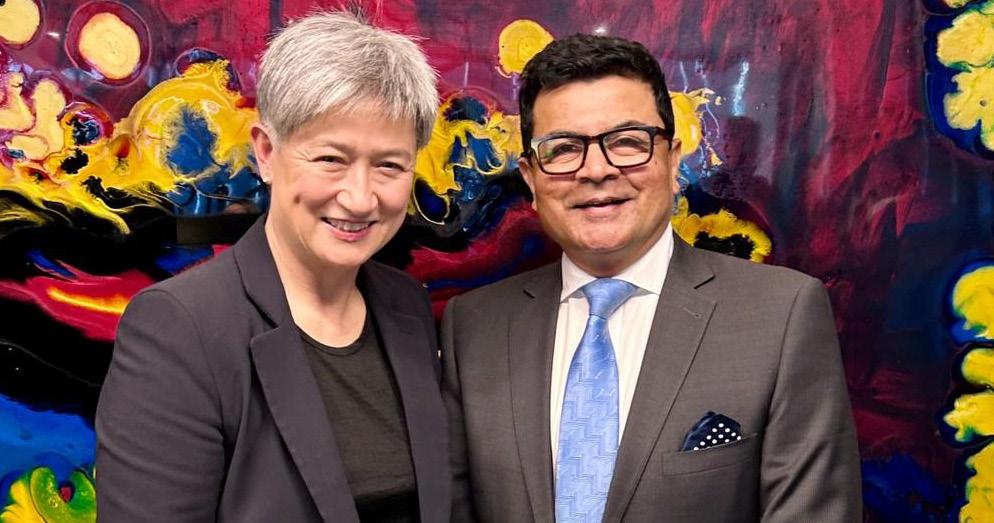
3 minute read
Indian Business Roundtable with Senator Penny Wong in Perth


Advertisement

Perth, 9 June (Australia India News News Bureau): The Indian Business Roundtable with the Hon. Penny Wong, Senator and Minister for Foreign Affairs, organised by Centre for Australia India Relations (CAIR) was held on June 9 in Perth, Western Australia. An invitation only event included guests from across the business, trade, state government and education sectors of the state. Kickstarting the Roundtable, the guests were welcomed by Mr. Tim Thomas, CEO- CAIR who thanked them for their participation and invited them to share their experiences, responsibilities and contributions towards AIECTA led bilateral engagement. He highlighted the importance of building relationships across the two countries at the bilateral level and emphasised the need to work towards delivering tangible outcome on all the key sectors identified in the AIECTA agreement.Hon. Senator Wong emphasised on the changing geopolitical dynamics around Australia especially in the Indo-Pacific region. She also emphasised on building a strong broad-based relationship and understanding with India. She said that there was a need to work towards making India and Australia the driving force in the region. She highlighted that we all need to be aware of our neighbours and friends in order tomake the right choices and make a stable rule-based ecosystem.

The key guests in the Roundtable included Senator Penny WongMinister for Foreign Affairs; Ms. Dimity Paul- Advisor to the Minister for Foreign Affairs; Hon. Matt Keogh MP- Minister for Veterans Affairs; Ms. Tania Lawrence MP- Member for Hasluck; Ms. Florence Drummond- Co-Founder and CEO, Indigenous Women in

Mining and Resources Australia, CAIR Advisory Board Member; Mr. Adam Gilchrist- University of Wollongong Global Brand Ambassador, CAIR Advisory Board Member; Mr.YazMubarakai MLA- Parliamentary Secretary to the Minister for Education, Aboriginal Affairs, Citizenship and Multicultural Interests; Mr. Michael Carter- President, AIBC Western Australia; Ms. Tamara Thorpe- Senior Business Development Manager, Western Australia, Tata Consulting Services; Mr. Fedele CamardaDeputy Chair, Western Rock Lobster Council; Ms. Gia Parish- Director, UWA Defence and Security Institute; Mr. Faz Pollard- Director, Adarsh Australia; Mr. Ram KuppusamyCEO, Space Angel; Ms.Neema Premji- Board member, AustraliaIndia Council; Dr. Parwinder Kaur- University of Western Australia School of Agriculture and Environment; Mr.Paritosh (Pari) Misra- Fuji Film / Vice President AIBC; Ms. Linda Dawson- DefenceWest; Mr. Vikas Rambal- Perdaman; Ms. Noelene Murray- CEO, Perdaman Global Services; Mr. Tim Thomas- CEO, CAIR; Mr. Ari Nagar- Director, CAIR; and Ms. Erin Maher- DFAT WA State Office Deputy Director.

New Delhi, June 14 (IANS) A new analysis which applies sustainability limits and minimises the need for carbon dioxide removal (CDR) finds new wind and solar needs to be installed five times faster by 2030 at a rate of 1.5 TW a year to limit global warming to 1.5 degrees Celsius.
Global wind and solar capacity needs to increase to around 10 TW by the end of this decade, up from 2 TW in 2022. This is achievable if the recent acceleration in capacity additions is maintained.
"Everyone from the EU to the
COP Presidency is calling for a global renewables target, but this must be based on the safest route to net zero. We've shown that if the world accelerates new wind and solar fivefold to at least 1.5 TW a year by 2030 while cutting fossil use by 40 per cent, we won't have to rely on potentially unsustainable amounts of carbon dioxide removal in the future," says Claire Fyson, Head of Policy at Climate Analytics.
The study distils key milestones the international community needs to meet by 2030 to keep warming below 1.5 degrees, including rapidly scaling up renewables this decade to 70 per cent of the global power mix, cutting greenhouse gas emissions by 8 per cent a year to halve global emissions by 2030, and a 34 per cent cut to global methane emissions over this critical decade for climate action.

Methane emissions in the energy
Village in Chhattisgarh’s Dantewada gets electricity after 75 yrs
sector would need to fall even faster, by 66 per cent.
"Our method takes only the latest global pathways with the most up-to-date information on technologies and costs. We know wind and solar can scale quickly and undercut fossil fuels on price. Our analysis shows they can do much of the heavy lifting so urgently needed this decade, so let's fast-track their rollout," says Neil Grant, Energy and Climate Analyst at Climate Analytics. Not all pathways in the IPCC AR6 database are fully compatible with the Paris Agreement. The study's method focuses on the latest 1.5-aligned pathways that integrate sustainability constraints, filtering out older analyses and those that rely too heavily on risky assumptions. As a result, the study finds just 0.1 per cent of global power would come from CCS by 2030.









